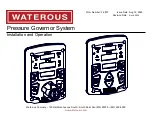40
to bounce around. When the room size is small, the “walls” of this space are
closer together and the resultant reflection density increases. When the room
size is large, that density decreases. The most natural reverbs use room sizes
that vary from about 24 meters to 45 meters or so, but there are many useful
reverbs that are outside of this range.
There is a relationship between this parameter and the MidRT parameter.
Please see the MidRT parameter for clarification.
RtHC Damping
The damping parameter is closely tied to the RTHC parameter. It controls
the strength of the hi frequency absorption and has three values: Light,
Normal, and Heavy. The normal value gives filter response identical to previ-
ous Lexicon
®
reverbs. The other values should be self-descriptive.
Scale
This parameter is used to modify the overall time of the selected early
impulse. It is a multiplier that goes from 0.5x to 2.0x. The actual time of the
responses varies from response to response. The Early Scale parameter simply
scales that amount of time. It’s fair to describe this a “rubber-banding” the
impulse response.
Selected LFO
This parameter determines which of the available LFOs may be used to con-
trol a voice. The voice may use the LFO output or the inverted LFO output.
Shape (Early Shape)
The Shape parameter is closely tied to the Spread parameter. Shape controls
how energy is injected into the reverberator. A low value means that sound
enters the reverb at the beginning of the spread window. A high value means
that most sound moves into the reverb at the end of the spread window. A
value somewhere in the middle means that sound enters the reverb evenly
across the spread window.
Tip
: Shape will not have this effect if spread is at its minimum value. But
even then, it can make a difference. In this case, it affects reverb tim-
bre and density. Higher values of shape will be both darker and denser,
although the effect is subtle.
Shelf
This parameter effects all filter types. It allows a certain amount of unfiltered
audio to be combined with the filtered audio. This effectively lowers the
effect of the filter. Another way of looking at it is that it lessens the normal
filter slope of 12 dB per octave. Unlike the traditional biquad filter, the shelf
is effective for all filter forms.
Signal Event Freq
Changes the rate of discreet signals from the signal generator. This only has
an effect when the signal type is set to sweep tones or pink click.
Signal Frequency
Changes the frequency of the signal generator sine wave. This only has an
effect when the signal type is set to sine wave.
Summary of Contents for PCM92
Page 1: ...Professional Audio Equipment ...
Page 8: ......
Page 12: ...6 ...
Page 40: ...34 ...
Page 49: ...43 PCM92 Menu Navigation Map System View and Machine View ...
Page 50: ...44 PCM92 Menu Navigation Map Stereo Hall Algorithms ...
Page 51: ...45 PCM92 Menu Navigation Map Stereo chamber and room Algorithms ...
Page 52: ...46 PCM92 Menu Navigation Map Stereo Delay Algorithms ...
Page 53: ...47 PCM92 Menu Navigation Map Stereo Effects Algorithms ...
Page 54: ...48 PCM92 Menu Navigation Map Mono Hall Algorithms ...
Page 55: ...49 PCM92 Menu Navigation Map Mono Chamber and room Algorithms ...
Page 56: ...50 PCM92 Menu Navigation Map Mono Delay Algorithms ...
Page 57: ...51 PCM92 Menu Navigation Map Mono Effects Algorithms ...
Page 58: ...52 ...
Page 63: ...57 ...


















